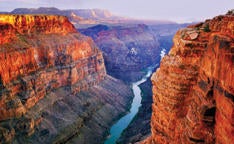How To Photograph The Grand Canyon
Learn important tips before embarking on your vacation.

1. For Great Skies, Visit During “Monsoon” Season:
From late July through early September, capture dramatic clouds and, if you’re lucky, lightning storms or rainbows in the distance.
2. Avoid Crowds By Going To The North Rim:
Open only in summer, it’s harder to reach than the South Rim. More than 1,000 feet higher and covered with forests, it’s more scenic, too.
3. Stick To Classic Overlooks To Shoot Panoramas At Dawn Or Dusk:
On the North Rim, Point Imperial and Cape Royal (better at sunset) reveal rock formations all the way down. On the South Rim, busy Hopi Point juts from a cliff into the heart of the canyon for views in every direction. Desert View and Navajo Point (less crowded and best for sunrise and sunset) look out on the winding Colorado River. At Desert View, compose around the landmark Desert View Watchtower.
4. Consider The Foreground:
The view of cliffs from Mather Point, South Rim, is close enough to let you crop out the sky and focus on detail. Tired of tourists? Wander off the beaten path in search of interesting details to highlight.
5. Hike One Of The Trails:
You can reach the popular South Kaibab trail by shuttle bus from the visitors’ center. The strenuous 6.5-mile trek lacks shade, but it follows a ridge for an open view in all directions. Bring plenty of water-you’ll walk for hours.
6. Capture The Action:
on a river trip down the Colorado. Tours are available at www. raftingthegrandcanyon.com. Bring a waterproof, shockproof camera case such as those made by Pelican (from $35, street; www.casesbypelican.com).
7. Get An Aerial Shot:
Willing to drop some cash? Starting at around $80, depending on length, helicopter tours offer a stunning view of hard-to-reach places such as Havasu Falls.
8. Don’t Forget Your Zoom:
More valuable than a wide-angle (though fisheyes can be fun) is a long lens to get new angles on classics and “zero in on things beneath the rim,” advises local photographer Mike Buchheit. Zoom in at sunrise and sunset, when moving clouds paint shadows on canyon walls.
9. Load Up Your Kit:
Bring a tripod, polarizing filter, and at least one split neutral-density filter.
10. Learn While You’re There:
Get insider tips on where and how to shoot the canyon from one of the local photo workshops, such as those offered by Grand Canyon Field Institute (www.grandcanyonassociation.org) and Friends of Arizona Highways (www.friendsofazhighways.com).